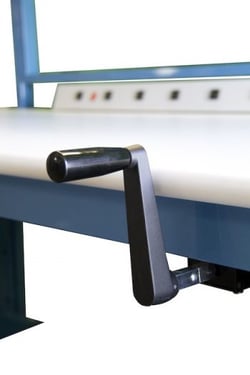Employers have the power to create work environments that either support or hinder their employees’ productivity and well-being, so it’s important to make thoughtful choices when designing a workplace.
The workbench is a central hub for many employees, where they spend a significant portion of their day completing tasks and collaborating with colleagues. Paying close attention to this workspace is crucial when your goal is to unlock greater productivity and comfort.
Elevate Workflow With The Right Lift Mechanism
Elevating your workflow begins with choosing the lift mechanism. The lift mechanism literally elevates the adjustable workbench and plays a major role in whether the workbench is ergonomically-friendly.
Ergonomics centers around maintaining a relaxed position that minimizes stress on a person’s joints and muscles. The relationship between the height of a person and the height of the workstation impacts this.
Studies show that ergonomic interventions can lead to improvements in productivity and workflow while reducing work-related musculoskeletal disorders.
Adjustable workbenches essentially shorten or elongate the legs of the bench so that an employee can sit or stand at a supportive level. This feature allows employees of all sizes and heights to adjust the workbench to a comfortable level.
There are four lift mechanism options for your industrial adjustable workbench:
-
Slot adjustment
-
Hand crank
-
Hand crank with hydraulic features
-
Electric
Slot Adjustment Workbench
With a slot adjustment bench, a worker must make adjustments by raising the work bench legs and removing bolts or spacers. This type of bench allows employees to adjust the height of the bench, but isn’t the most ergonomically-friendly option because it requires the worker to manually lift the bench.
Hand Crank Adjustable Workbench
A hand crank adjustable height workbench is manual in design, but allows employees to rotate a hand crank to lift or lower the bench. A hand crank makes the process of lifting the workbench easier for workers, but if there are heavy tools, products or other objects on the bench, it may be difficult to raise and lower the worksurface.
lower the bench. A hand crank makes the process of lifting the workbench easier for workers, but if there are heavy tools, products or other objects on the bench, it may be difficult to raise and lower the worksurface.
Hand Crank Workbench With Hydraulic Features
When cranked, the hydraulic fluid in the cylinders force the shafts in the legs to elevate. This pressure that lowers or lifts the work surface makes the process easier, especially with heavy duty workbenches that hold heavy loads. Depending on the workbench you purchase, hydraulic adjustable versions can lift up to 1,000 pounds.
Electric Adjustable Height Workbench
 An electric adjustable height workbench provides some of the highest levels of ergonomic support in a workspace. An employee can easily lift or lower the surface with the simple push of a button.
An electric adjustable height workbench provides some of the highest levels of ergonomic support in a workspace. An employee can easily lift or lower the surface with the simple push of a button.
If there are heavy work tools on the bench, a bench with an electrical component will also require less physical effort to raise the bench than hand cranking the bench. Depending on the model, you may be able to preset positions for convenience as well. This can come in handy if multiple workers use the same bench in multi-shift operations.
How To Choose A Lift Mechanism
When choosing a lift mechanism, you should take into consideration several factors, including:
-
Your facility’s needs
-
Your budget
-
The level of ergonomic support you want to provide
While a hand crank adjustable bench still allows your workers to adjust the height of the bench, it’s not the most ergonomically-friendly option. However, this model may be more budget-friendly depending on what other customizations you include. No electricity is required as well, so the work station isn’t tied to a particular location.
On the other hand, an electric adjustable height workbench is faster, requires less effort, can typically handle higher weight capacities, and you don’t have to worry about oil leaks that may come with hydraulic benches over time with heavy use. One downside is that this style may be at the top of price ranges.
Reduce Workflow Interruptions With A Height Adjustable Workbench
A major disruptor of workflow and productivity in industrial applications is missed work due to musculoskeletal injuries.
Musculoskeletal injuries, such as strains, sprains, and repetitive motion injuries, can have a significant impact on workflow and productivity in the workplace. According to the Bureau of Labor Statistics (BLS), musculoskeletal disorders account for about 30% of cases that cause employees to miss work. The Occupational Safety and Health Administration also reports that MSDs are among the most popular reasons behind restricted work time.
These types of injuries can occur when employees engage in repetitive motions, heavy lifting or other activities that put strain on the body. Missed work due to these types of injuries can disrupt workflow and productivity in several ways.
When an employee misses work due to a musculoskeletal injury, it can cause a backlog of tasks and responsibilities that must be handled by other employees, which can lead to increased stress and a decrease in productivity. When an employee is away from work, it can lead to delays in project completion, which can negatively impact deadlines and client satisfaction.
When an employee returns to work after a musculoskeletal injury, they may be limited in the tasks they are able to perform, which can further disrupt workflow and productivity. They may require accommodations such as modified work schedules or special equipment, which can require additional resources and coordination.
Musculoskeletal injuries can also have long-term effects on an employee's ability to perform their job, which can lead to decreased productivity over time. It can even lead to an increase in medical cost and disability claims.
Implementing ergonomic interventions and promoting healthy work practices can help prevent musculoskeletal injuries and promote a more productive and efficient workforce.
Maximize Productivity With Storage And Organization
Storage and organization in a workbench are essential for enhancing workflow. When tools and materials are easily accessible and organized, it reduces the time and effort required to find and retrieve them. This can help employees work more efficiently, as they can quickly access the tools and materials they need without having to search for them or disrupt their workflow.
accessible and organized, it reduces the time and effort required to find and retrieve them. This can help employees work more efficiently, as they can quickly access the tools and materials they need without having to search for them or disrupt their workflow.
A well-organized workbench can help prevent clutter and disorganization, which can lead to lost or misplaced items and wasted time. A workbench with the proper storage features can help to keep a work area clean and reduce the risk of accidents. By having everything in its place, the work area will be free of obstacles, allowing employees to move around easily and work more comfortably.
An adjustable workbench with drawers can come in a variety of designs and configurations. In fact, there are several different drawer configuration options. For example, in the same amount of space, you could fit:
-
Four 3-inch drawers and two 6-inch drawers
-
Two 3-inch drawers and three 6-inch drawers
-
Eight 3-inch drawers
-
Four 3-inch drawers and one 12-inch drawer
-
Four 3-inch drawers and one 12-inch locker (with left or right opening)
Drawer configuration is just one of the decisions you have available to you. Design elements like full extension and heavy duty roller bearing slides, which allow you to effortlessly open and close drawers, are important to consider, as are your security requirements and handle options.
If your workspace requires heavy security, you might want to consider locks on drawers, which can be keyed the same or all differently. Handle options include plastic cup handles, aluminum cup pull handles, full finger steel pull handles that run the length of the drawer, lab-grade aluminum handle pulls and chrome wire pulls.
Other storage and organization features include:
-
Utility drawers that come in a variety of sizes and configurations
-
Upper and lower shelves that can be installed below or above the work surface
-
Upper storage cabinets with flipper doors that hold supplies
-
Articulating monitor arms that can accommodate flat screens and laptops
-
Keyboard trays that can be added to any work surface or articulating arm
-
CPU holders that can be fixed or adjustable
-
Pegboards that can be added between the uprights to attach tools
-
Bin rails or panels to store parts and accessories
In environments where employees have to move around in order to accomplish a task, a mobile industrial workbench may provide greater flexibility and reduce the number of workstations needed. Mobile workbenches include casters that make the workspace movable. Make sure the casters are industrial strength and can withhold the weight of your adjustable height work table.
Overall, storage and organization in a workbench can help to streamline processes, increase efficiency and improve the overall productivity of an employee.
Customization Solutions For A Better Workflow
A good manager knows there is no “one size fits all” solution to any problem. While ergonomically-friendly workstations and storage solutions can benefit any employee, adjustable workbenches provide an even greater level of customizability that promote better health and workflow.
By allowing employees to adjust the height range of the work surface to their specific needs, a height adjustable workbench can help reduce the risk of injuries and improve overall comfort. With the right combination of ergonomic design and organization, this type of workstation can help to create a more efficient and productive work environment.


